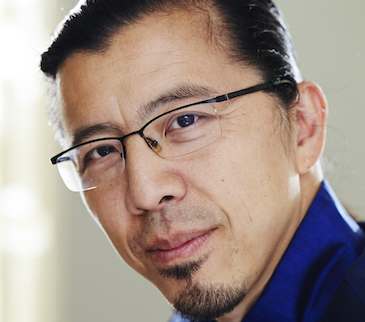We work on blend extensively in our ensemble. In a string quartet or a brass quintet all musicians produce sound in a similar way. A wind quintet is unusual in that it includes five instruments that have very different tone qualities and sound production. Oboe and bassoon are at least related, but flute, clarinet, and French horn have distinct timbres and produce sound differently.
For example, in Ibert there are sections where horn and flute play an accompaniment together of short repeated ostinato notes. This motif sounds completely different on a horn than on a flute, especially in the low register. We continuously work to match the sound between the flute and the horn as close as possible for the particular acoustical environment. You have to constantly adjust the length, loudness, and color of your sound to achieve better fit with the other instruments. David sometimes places all instruments in a lower register in his arrangements. That creates certain challenges for the players but it helps improve the blend.
To work on blend you must perfect your technique. Blend requires enormous flexibility, especially from the horn player. Sometimes when you listen to a wind quintet, the horn will stand out. The ensemble becomes a group of four wind instruments against one brass instrument. But a horn can produce a soft and mellow sound that can fit very well, especially with a flute and a clarinet. It is very important that the horn player plays soft in a wind quintet. The way you attack a note on a horn makes a tremendous difference in the blend with other instruments. If you cut off the initial attack of a note, a recorded note on a flute and a horn are almost indistinguishable. The attack and the release of a note is what makes the instruments sound so different. The attack on the horn is naturally longer and louder than on a flute, and a horn player must learn how to control it. Blend is achievable between a flute and a horn, but it requires a vast amount of work.
As a player in an ensemble you always have to know precisely the role you have in a piece. Many original classical pieces were written for a sextet or octet in which composers arranged various sections for pairs of instruments – 2 horns, 2 bassoons, etc. When we perform the same repertoire in a wind quintet, suddenly a clarinet has to act as the second horn. In that instance the clarinet needs a broader open sound to match the horn, instead of the natural focused sound of the instrument. But when playing with a flute, the clarinet has to act as a second flute. Then, you will need to find brilliance in your sound to create a better blend. Flexibility is really the key.
Each instrument in a wind quintet has its own distinctive color, but in ensemble playing you have to reduce some of your original color. In some instances when you have the melody you have to be able to go back to your original sound. For example, when a clarinet has a soft solo accompanied by the four other instruments, the only way to stand out without playing too loud is by having a different color from the rest of the ensemble.
The structure of each section will dictate how you have to approach your sound, articulation, dynamic, etc. You need to be very attentive and honest about your intonation. Each of our instruments have notes which are more difficult to play in tune. For example, if a bassoon has a very low note with less stable intonation, the other instruments need to adjust and help to create the perfect blend. The most difficult aspect of playing in a wind quintet is the constant and very sudden alteration of roles; from a brilliant solo you often have to suddenly switch to a soft and blended accompaniment. You have to be like a chameleon, able to lose your distinct sound and find it back again within a couple notes without any preparation time. That is the biggest difference between playing in a wind quintet and playing in an orchestra. Very often in an orchestral work you will have few bars of rest where you can prepare and possibly even switch reeds for a beautiful solo. In a wind quintet that is not an option.
Niels Anders and David M.A.P. Palmquist have played in Carion since the foundation of the ensemble in the early 2000s. Egīls Šēfers joined Carion in 2008. Dóra Seres was the last to join the quintet in its current form. It was challenging for her to adjust to the blended sound of the ensemble. At first she tried playing as a soloist, but she soon realized that playing in a wind quintet required a new set of skills. Dóra experimented with playing without vibrato, using a bright and round sound, and even losing some of her brilliance as a soloist. She continuously worked on mimicking a sound of a horn, a clarinet, an oboe, or a bassoon. Once Dóra was able to play the right way, it felt much more comfortable and enjoyable playing with the group.
Egils Upatnieks, the principal oboe of the Latvian Symphony Orchestra, constantly has to make adjustments between playing in the symphony orchestra and playing in the wind quintet. Sometimes he has to take a red-eye flight early in the morning to get to a performance with Carion. The night before he might have performed with the Latvian Symphony Orchestra, playing with a big sound in a large symphony. The next day’s performance with Carion might be in an acoustically dry concert hall. He will need to use different reeds, equipment, and mindset as well. Being able to adapt is a key.
Revised and edited by Claire Thompson, PhD.

CARION Wind Quintet
CARION is a prize-winning Danish-Latvian wind quintet. The ensemble has performed in Rheingau Festival, Kissinger Sommer, Beethovenfest Bonn, Bergen Festival and Louisiana Festival as well as in the Far East.
CARION has released 5 highly critically acclaimed CDs – including stellar reviews from Gramophone and BBC magazine, awards from Danish radio and best classical album of 2015 on iTunes.



Comments are closed.